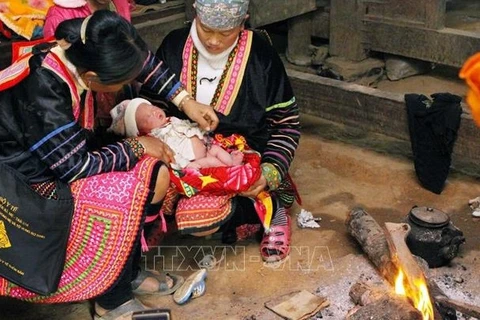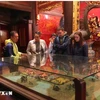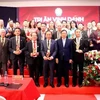 Visitors learn about objects in the collection of Mark Rapoport, an American doctor who has been living in Vietnam for more than 20 years. When listening to his talk for hours and hours about the objects he found by chance on trips to different mountainous regions, it is easy to see Mark Rapoport's passion for the ethnic groups of Vietnam. Earlier in May 2022, Mark donated 500 objects from his collection to the Vietnamese Women’s Museum. According to Nguyen Thi Tuyet, deputy director of the museum, the objects that Mark donated to the museum are very valuable, as it may be hard to find the same things now, as times have changed. (Photo: Vietnamplus)
Visitors learn about objects in the collection of Mark Rapoport, an American doctor who has been living in Vietnam for more than 20 years. When listening to his talk for hours and hours about the objects he found by chance on trips to different mountainous regions, it is easy to see Mark Rapoport's passion for the ethnic groups of Vietnam. Earlier in May 2022, Mark donated 500 objects from his collection to the Vietnamese Women’s Museum. According to Nguyen Thi Tuyet, deputy director of the museum, the objects that Mark donated to the museum are very valuable, as it may be hard to find the same things now, as times have changed. (Photo: Vietnamplus)  Mark Rapoport speaks at a ceremony to donate his collected objects to the Vietnamese Women’s Museum. In 1969, Mark was one of the few American doctors who volunteered to join treatment groups for Vietnamese ethnic minority people in the central region. In the summer of that year, Mark was in his final year of medical school, when the American War in Vietnam dominated the headlines. He was strongly against the war, protesting, signing petitions and contributing money. The American Medical Association each year sent 100 doctors to Vietnam to work in hospitals caring for Vietnamese civilians. As he was not yet a qualified doctor, he was assigned to do a research paper in Vietnam. Since then, he developed a passion for traditional cultures of Vietnamese ethnic minority groups. (Photo: Vietnamplus)
Mark Rapoport speaks at a ceremony to donate his collected objects to the Vietnamese Women’s Museum. In 1969, Mark was one of the few American doctors who volunteered to join treatment groups for Vietnamese ethnic minority people in the central region. In the summer of that year, Mark was in his final year of medical school, when the American War in Vietnam dominated the headlines. He was strongly against the war, protesting, signing petitions and contributing money. The American Medical Association each year sent 100 doctors to Vietnam to work in hospitals caring for Vietnamese civilians. As he was not yet a qualified doctor, he was assigned to do a research paper in Vietnam. Since then, he developed a passion for traditional cultures of Vietnamese ethnic minority groups. (Photo: Vietnamplus)  Mark Rapoport and Vietnamese ethnic minority women. He recalled a memory of visiting an ethnic group village in Vietnam when he fell in love at the first sight with a lovely basket for holding cooked rice. He said the woman using the basket saw him and before he could say a word, she put the rice into another basket, and offered him the one that he had gazed at and asked for his money. He gave her 2 dollars and claimed his treasure. Mark could not hide his bliss when recalling that memorable experience. He said he was very happy to get the woman’s lovely rice basket. (Photo: Vietnamplus)
Mark Rapoport and Vietnamese ethnic minority women. He recalled a memory of visiting an ethnic group village in Vietnam when he fell in love at the first sight with a lovely basket for holding cooked rice. He said the woman using the basket saw him and before he could say a word, she put the rice into another basket, and offered him the one that he had gazed at and asked for his money. He gave her 2 dollars and claimed his treasure. Mark could not hide his bliss when recalling that memorable experience. He said he was very happy to get the woman’s lovely rice basket. (Photo: Vietnamplus)  Bracelets from the collection of Mark Rapoport. Wearing bracelets is not only for aesthetic purposes but also has a special meaning in the spiritual life of many Vietnamese ethnic groups. For example, thread bracelet tying originated from the belief of Thai ethnic people that humans are born with a soul and body parts, of which the soul is more important. A thread bracelet is believed to keep a person safe from evil and serves as a sign of marriage or being protected by a shaman. A visitor to the home will be welcomed with a thread bracelet which means that visitor is considered a family member. (Photo: Vietnamplus)
Bracelets from the collection of Mark Rapoport. Wearing bracelets is not only for aesthetic purposes but also has a special meaning in the spiritual life of many Vietnamese ethnic groups. For example, thread bracelet tying originated from the belief of Thai ethnic people that humans are born with a soul and body parts, of which the soul is more important. A thread bracelet is believed to keep a person safe from evil and serves as a sign of marriage or being protected by a shaman. A visitor to the home will be welcomed with a thread bracelet which means that visitor is considered a family member. (Photo: Vietnamplus)  Betel nut box. In Vietnam, the custom of chewing betel dates back to the reign of the Hung Kings. It is associated with the “Legend of Betel and Areca” about a wife’s faithfulness to her husband and the love between two siblings. They are a symbol of love, brotherhood, family, and happiness. Betel and areca have not only appeared in Vietnamese folklore, folk verses, folk songs, and folk festivals, but have become an indispensable part of Vietnamese people’s daily life. Betel and areca are used to start a conversation and help people become closer and more open with each other. They serve as offerings in important traditional ceremonies, such as offering rituals, engagements, weddings, funerals, and burials. (Photo:Vietnamplus)
Betel nut box. In Vietnam, the custom of chewing betel dates back to the reign of the Hung Kings. It is associated with the “Legend of Betel and Areca” about a wife’s faithfulness to her husband and the love between two siblings. They are a symbol of love, brotherhood, family, and happiness. Betel and areca have not only appeared in Vietnamese folklore, folk verses, folk songs, and folk festivals, but have become an indispensable part of Vietnamese people’s daily life. Betel and areca are used to start a conversation and help people become closer and more open with each other. They serve as offerings in important traditional ceremonies, such as offering rituals, engagements, weddings, funerals, and burials. (Photo:Vietnamplus)  Some statues from the collection of Mark Rapoport. According to Nguyen Thi Tuyet, deputy director of the Vietnam Women’s Museum, the museum has invited experts in ethnology and archaeology to examine the objects and they all said the objects are beautiful and valuable. She said that the museum is very proud to be trusted by Mark and hopes to further introduce the objects and cultural values to the public. Tuyet described Mark as an enthusiastic person that has been very helpful to the museum. Since 2010, he has donated many objects to the museum, which is meaningful in the context that the museum has a limited budget for collecting things. (Photo: Vietnamplus)
Some statues from the collection of Mark Rapoport. According to Nguyen Thi Tuyet, deputy director of the Vietnam Women’s Museum, the museum has invited experts in ethnology and archaeology to examine the objects and they all said the objects are beautiful and valuable. She said that the museum is very proud to be trusted by Mark and hopes to further introduce the objects and cultural values to the public. Tuyet described Mark as an enthusiastic person that has been very helpful to the museum. Since 2010, he has donated many objects to the museum, which is meaningful in the context that the museum has a limited budget for collecting things. (Photo: Vietnamplus)  Wooden puppet (Vietnamese: Mua roi nuoc). Water puppetry is a tradition that dates back as far as the 11th century when it originated in the villages of the Red River Delta area of northern Vietnam. Today's Vietnamese water puppetry is a unique variation on the ancient Asian puppet tradition. The puppets are made out of wood and then lacquered. The shows are performed in a waist-deep pool. A large bamboo rod supports the puppet under the water and is used by the puppeteers to control them. They are normally hidden behind a screen. Therefore, the puppets appear to be moving over the water. (Photo: Vietnamplus)
Wooden puppet (Vietnamese: Mua roi nuoc). Water puppetry is a tradition that dates back as far as the 11th century when it originated in the villages of the Red River Delta area of northern Vietnam. Today's Vietnamese water puppetry is a unique variation on the ancient Asian puppet tradition. The puppets are made out of wood and then lacquered. The shows are performed in a waist-deep pool. A large bamboo rod supports the puppet under the water and is used by the puppeteers to control them. They are normally hidden behind a screen. Therefore, the puppets appear to be moving over the water. (Photo: Vietnamplus)  Close-up view of a statue. American doctor Mark Rapoport shared that if he saw something he had never seen before, he would always buy it. He added that he likes mysteries. To uncover the mysteries, he would love to talk to a lot of people, go on the internet, and try to find out what an object is made from and what it is used for. He said that he loves the exploration of new knowledge. This statue is one of the objects that Mark donated to the Vietnamese Women’s Museum. It has significant spiritual meaning in the Vietnamese ethnic groups. (Photo: Vietnamplus)
Close-up view of a statue. American doctor Mark Rapoport shared that if he saw something he had never seen before, he would always buy it. He added that he likes mysteries. To uncover the mysteries, he would love to talk to a lot of people, go on the internet, and try to find out what an object is made from and what it is used for. He said that he loves the exploration of new knowledge. This statue is one of the objects that Mark donated to the Vietnamese Women’s Museum. It has significant spiritual meaning in the Vietnamese ethnic groups. (Photo: Vietnamplus)  The copper chicken iron was common among Vietnamese in the 20th century. This iron was made in France, cast in copper to keep heat when it contains hot coals inside. It was called a chicken iron because on the top of the iron lid has a chicken-shaped part, which was made of cold copper so as not to absorb heat from the hot coal inside. With this design, users will not have their hands burnt when holding the chicken's head to open or close the iron lid. Today, antique lovers are willing to spend a lot of money buying a copper chicken iron. (Photo: Vietnamplus)
The copper chicken iron was common among Vietnamese in the 20th century. This iron was made in France, cast in copper to keep heat when it contains hot coals inside. It was called a chicken iron because on the top of the iron lid has a chicken-shaped part, which was made of cold copper so as not to absorb heat from the hot coal inside. With this design, users will not have their hands burnt when holding the chicken's head to open or close the iron lid. Today, antique lovers are willing to spend a lot of money buying a copper chicken iron. (Photo: Vietnamplus)  Exquisite inlaid betel nut box. A betel quid consists of four materials: a wedge of areca nut which has a sweet taste, a betel leaf that offers a spicy taste, a piece of bark of a special tree which gives a bitter taste, and a little lime paste offering a hot taste. All of them are chewed together, providing a delicious taste with red juice and freshness. A betel kit includes a knife for splitting the areca nuts and shaping the betel leaves, a pot of lime, a tube of lime paste, a little stick used to spread lime paste on the betel leaf, and all exist in a great variety. There are also trays, containers, baskets, boxes, bags, and handkerchiefs to contain the betel, areca and small items. (Photo: Vietnamplus)
Exquisite inlaid betel nut box. A betel quid consists of four materials: a wedge of areca nut which has a sweet taste, a betel leaf that offers a spicy taste, a piece of bark of a special tree which gives a bitter taste, and a little lime paste offering a hot taste. All of them are chewed together, providing a delicious taste with red juice and freshness. A betel kit includes a knife for splitting the areca nuts and shaping the betel leaves, a pot of lime, a tube of lime paste, a little stick used to spread lime paste on the betel leaf, and all exist in a great variety. There are also trays, containers, baskets, boxes, bags, and handkerchiefs to contain the betel, areca and small items. (Photo: Vietnamplus)  Metal broaches collection. At the Vietnamese Women’s Museum, there are many ornaments on display. Women adorn themselves with many jewels, bracelet, necklace, earrings, pins, made with varied materials, differently shaped and decorated according to the regions and populations. For example, the women in the highland areas are interested in wearing large, spiraled rings in copper. Their necklaces are in pearls of many colours or in agate. The earrings are in ivory or in bamboo, and the jewelry is in silver. Wearing some jewelry is believed to protect people against bad spirits or as a lucky charm. It also shows social status. (Photo: Vietnamplus)
Metal broaches collection. At the Vietnamese Women’s Museum, there are many ornaments on display. Women adorn themselves with many jewels, bracelet, necklace, earrings, pins, made with varied materials, differently shaped and decorated according to the regions and populations. For example, the women in the highland areas are interested in wearing large, spiraled rings in copper. Their necklaces are in pearls of many colours or in agate. The earrings are in ivory or in bamboo, and the jewelry is in silver. Wearing some jewelry is believed to protect people against bad spirits or as a lucky charm. It also shows social status. (Photo: Vietnamplus)  Hair ornaments. In Vietnam, women are always wearing hats, headdresses, or turbans and adorned themselves with pins, combs, or silver coins. For example, the Yao Thanh Y and the Yao Lan Ten ethnic women cover their chignon with headdresses decorated with large silver or aluminum jewel. The red Yao is heavy red headdresses. The Yao Thanh Phan of the northern province of Quang Ninh shave their hair and put a layer of beeswax on their hair before covering it with the headdress, according to the museum. Other jewels such as pins, earrings, necklaces, and toiletries ornaments can be in silver, bronze, agate, ivory, pearls bone, or aluminum. The silver jewelry is appreciated by the populations of the northern mountains because they are considered hunters of bad winds and show wealth and nobility. (Photo: Vietnamplus)
Hair ornaments. In Vietnam, women are always wearing hats, headdresses, or turbans and adorned themselves with pins, combs, or silver coins. For example, the Yao Thanh Y and the Yao Lan Ten ethnic women cover their chignon with headdresses decorated with large silver or aluminum jewel. The red Yao is heavy red headdresses. The Yao Thanh Phan of the northern province of Quang Ninh shave their hair and put a layer of beeswax on their hair before covering it with the headdress, according to the museum. Other jewels such as pins, earrings, necklaces, and toiletries ornaments can be in silver, bronze, agate, ivory, pearls bone, or aluminum. The silver jewelry is appreciated by the populations of the northern mountains because they are considered hunters of bad winds and show wealth and nobility. (Photo: Vietnamplus)  Paintings of female goddesses become the source of inspiration for Mark’s research. Worshipping female goddesses has significant meaning in the Vietnamese spiritual life. The country has long had a traditional practice of worshiping Mother Goddess. The belief in this ritual reflects people’s strong desire for health, wealth, and fortune. The practitioners are comprised of temple guardians, ritual priests, spirit mediums, mediums’ assistants, and musicians. They perform the songs for the spirits, disciples and lay adherents who share the same beliefs in the spiritual power, supernatural strength, and protection of the Mother Goddess spirit pantheon. All these practitioners form groups who worship together, take part in traditional festivals and perform spirit possession rituals at temples and palaces dedicated to Mother Goddesses. (Photo: Vietnamplus)
Paintings of female goddesses become the source of inspiration for Mark’s research. Worshipping female goddesses has significant meaning in the Vietnamese spiritual life. The country has long had a traditional practice of worshiping Mother Goddess. The belief in this ritual reflects people’s strong desire for health, wealth, and fortune. The practitioners are comprised of temple guardians, ritual priests, spirit mediums, mediums’ assistants, and musicians. They perform the songs for the spirits, disciples and lay adherents who share the same beliefs in the spiritual power, supernatural strength, and protection of the Mother Goddess spirit pantheon. All these practitioners form groups who worship together, take part in traditional festivals and perform spirit possession rituals at temples and palaces dedicated to Mother Goddesses. (Photo: Vietnamplus)  Worshiping paintings of female goddesses. The Vietnamese beliefs in the Mother Goddesses has four central tenets, all of which are associated with the community. First, it considers nature as a mother and worships her. Second, it brings to people living in this world three things: happiness, prosperity and longevity. These are the eternal wishes of humans. Third, it clearly reflects patriotism, which is the people’s spirit and belief. This is shown by the fact that almost 50 genies worshipped by the Mother Goddesses beliefs are historical celebrities who have rendered great services to the nation. Vietnam’s tradition of worshipping Mother Goddesses was recognised as an Intangible Cultural Heritage of Humanity by the UN cultural agency UNESCO in 2016. (Photo: Vietnamplus)
Worshiping paintings of female goddesses. The Vietnamese beliefs in the Mother Goddesses has four central tenets, all of which are associated with the community. First, it considers nature as a mother and worships her. Second, it brings to people living in this world three things: happiness, prosperity and longevity. These are the eternal wishes of humans. Third, it clearly reflects patriotism, which is the people’s spirit and belief. This is shown by the fact that almost 50 genies worshipped by the Mother Goddesses beliefs are historical celebrities who have rendered great services to the nation. Vietnam’s tradition of worshipping Mother Goddesses was recognised as an Intangible Cultural Heritage of Humanity by the UN cultural agency UNESCO in 2016. (Photo: Vietnamplus)  Mark’s first two objects of “tribal art”. Mark’s collection also has considerable variety of other items such as a rice cutter from the Tay ethnic minority people in the northern mountainous region, made of wood with a bamboo handle, carved in the shape of a snail; shipwrecked ceramic boxes founded near the Cham island in the central part of Vietnam, dating back to the 15th century painted with lotus flowers, peach blossoms and other flora. There are also a great deal of tribal textile products including baby carriers, scarves, blankets, skirts or wedding scarves, in addition to Vietnamese urban antiques, Buddhist statues and ceramic items. (Photo:Vietnamplus)
Mark’s first two objects of “tribal art”. Mark’s collection also has considerable variety of other items such as a rice cutter from the Tay ethnic minority people in the northern mountainous region, made of wood with a bamboo handle, carved in the shape of a snail; shipwrecked ceramic boxes founded near the Cham island in the central part of Vietnam, dating back to the 15th century painted with lotus flowers, peach blossoms and other flora. There are also a great deal of tribal textile products including baby carriers, scarves, blankets, skirts or wedding scarves, in addition to Vietnamese urban antiques, Buddhist statues and ceramic items. (Photo:Vietnamplus)  Visitors to the ceremony have a chance to get the “101 Reasons to Love Living in Hanoi” book. In this book, Mark and his wife and children have put together a list of 101 reasons why they love living in Hanoi. Some of the reasons are: The Vietnamese people are the hardest-working, least-complaining, most optimistic folks anywhere. The city is an extremely safe place, where foreign teenagers can go walking and make their own adventures. Hanoi is a city of lakes, dozens of them, many surrounded by parks and walks. Nowhere has Marked seen so many fathers taking care of their kids (without any complaining) as he does in Hanoi. And this applies to their daughters as well as their sons. (Photo: Vietnamplus)
Visitors to the ceremony have a chance to get the “101 Reasons to Love Living in Hanoi” book. In this book, Mark and his wife and children have put together a list of 101 reasons why they love living in Hanoi. Some of the reasons are: The Vietnamese people are the hardest-working, least-complaining, most optimistic folks anywhere. The city is an extremely safe place, where foreign teenagers can go walking and make their own adventures. Hanoi is a city of lakes, dozens of them, many surrounded by parks and walks. Nowhere has Marked seen so many fathers taking care of their kids (without any complaining) as he does in Hanoi. And this applies to their daughters as well as their sons. (Photo: Vietnamplus)  Mark Rapoport shared that he donated these objects to the Vietnamese Women’s Museum because he admires and trusts the management of the facility. At the museum, visitors learn about the roles of Vietnamese women through the amazing and impressive exhibitions. The women’s stories are simple, but insightful. Love, sacrifices, and silent contributions form the temperament, beauty and importance of Vietnamese women and their crucial roles in the past, present and future. The museum has been collecting, preserving and introducing these values, and heritages to domestic and international visitors in hope that everyone will love, respect and be proud of Vietnamese women. (Photo: Vietnamplus)
Mark Rapoport shared that he donated these objects to the Vietnamese Women’s Museum because he admires and trusts the management of the facility. At the museum, visitors learn about the roles of Vietnamese women through the amazing and impressive exhibitions. The women’s stories are simple, but insightful. Love, sacrifices, and silent contributions form the temperament, beauty and importance of Vietnamese women and their crucial roles in the past, present and future. The museum has been collecting, preserving and introducing these values, and heritages to domestic and international visitors in hope that everyone will love, respect and be proud of Vietnamese women. (Photo: Vietnamplus) VNA






















